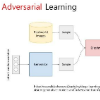Retinal vessel segmentation plays a key role in computer-aided screening, diagnosis, and treatment of various cardiovascular and ophthalmic diseases. Recently, deep learning-based retinal vessel segmentation algorithms have achieved remarkable performance. However, due to the domain shift problem, the performance of these algorithms often degrades when they are applied to new data that is different from the training data. Manually labeling new data for each test domain is often a time-consuming and laborious task. In this work, we explore unsupervised domain adaptation in retinal vessel segmentation by using entropy-based adversarial learning and transfer normalization layer to train a segmentation network, which generalizes well across domains and requires no annotation of the target domain. Specifically, first, an entropy-based adversarial learning strategy is developed to reduce the distribution discrepancy between the source and target domains while also achieving the objective of entropy minimization on the target domain. In addition, a new transfer normalization layer is proposed to further boost the transferability of the deep network. It normalizes the features of each domain separately to compensate for the domain distribution gap. Besides, it also adaptively selects those feature channels that are more transferable between domains, thus further enhancing the generalization performance of the network. We conducted extensive experiments on three regular fundus image datasets and an ultra-widefield fundus image dataset, and the results show that our approach yields significant performance gains compared to other state-of-the-art methods.
翻译:视网膜分解在计算机辅助的筛选、诊断和治疗各种心血管和眼科疾病中发挥着关键作用。最近,深学习的视网膜视网膜分解算法取得了显著的性能。然而,由于领域转移问题,这些算法的性能在应用到与培训数据不同的新数据时往往会退化。为每个测试领域手工标注新数据往往是一项耗时和艰巨的任务。在这项工作中,我们探索未经监督的对视网膜分解域的调整,利用基于内流的对抗性学习和转移正常化层来训练一个分解网络,这个网络在各个领域非常普及,不需要说明目标领域的情况。具体地说,这些算法的性能往往会降低源域和目标领域之间的分布差异,同时实现在目标领域最大限度地最小化目标领域的目标。此外,我们提议新的转移法正常化,以进一步加强深网络的可转移性能。它使每个领域的特性正常化,以弥补域域间分布网的广度和超广域域域域域域域域图的对比,因此,我们又选择了较大规模的业绩实验性化数据,从而显示整个域域域域域域图象化。



